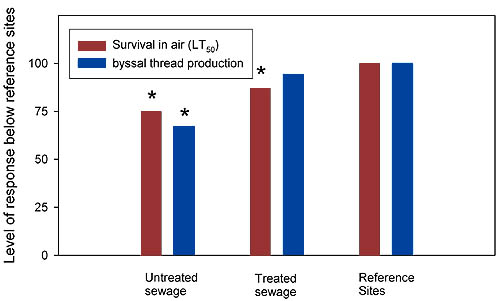

|
| Error processing SSI file |
|
||
|
Mussel Physiology as Sewage Bioindicator 
Figure 1. Median survival in air (LT50) and byssal
threads produced every 48 hours for mussels from two sewage outfalls and two
reference sites. Values are reported as a percent of the response elicited from
reference site mussels. Asterisks indicate significant difference (P<0.05) from
paired reference site mussels. Mussels (Mytilus trossulus), were sampled from four Juneau-area beaches
in Southeast Alaska: one beach that received untreated sewage for several
years, a second beach adjacent to a secondary wastewater outfall, and
two nearby reference beaches. Average shell length measured 43 mm. Survival
time of the mussels in air, byssal thread production rate, and the prevalence
of trematode parasites were determined for each group. Tolerances to aerial
exposure were significantly lower at both sewage outfall sites than at
reference sites. Mussels exposed to untreated sewage produced fewer byssal
threads and had a significantly higher prevalence of encysted trematodes
than mussels from the other beaches, including the secondary wastewater
site (Fig. 1 above). Survival in air, byssal thread production, and trematode
prevalence in mussels may be useful indicators in evaluating the long-term
health of beaches exposed to sewage.
|
|
AFSC Quarterly Feature Auke Bay Lab National Marine Mammal Lab RACE Division REFM Division Quarterly Index Quarterly Home |
|
|
||
|
|
||